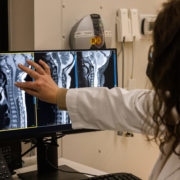
Like many people, you probably spend a lot of time using your phone. According to one study, the average adult spends more than five hours a day on their devices, a habit that can cause a literal pain in the neck. All that time spent with your neck bent forward can cause a condition known as “tech neck.”
A type of repetitive use injury, tech neck causes pain and stiffness in the neck muscles. Neck exercises and changes to your habits can help prevent and alleviate the pain of this distinctly modern ailment — and help you avoid long-term spine damage.
What Is Tech Neck?
Doctors use the term tech neck to refer to the stiffness, soreness, and pain in the neck, shoulders, and upper back from using technology. While it is most commonly associated with handheld mobile devices, tech neck syndrome is also associated with working on a computer.

When you use a phone or computer, the muscles in your neck contract to support the weight of your head. The longer you hold the position without relaxing, the more these muscles have to work. Eventually, they become stiff, tired, and sore, just like any other overused muscle in your body.
This soreness occurs because the amount of weight that your spine bears increases with every inch you bend your neck forward. The average adult head weighs 10 pounds, but if you tilt forward just 45 degrees, your neck muscles and joints have to work as if supporting close to 50 pounds.
The Long Term Effects of Tech Neck
Doctors estimate that most adults experience tech neck at some point. For many people, a sore neck or upper back pain is simply a fact of life.
Stiffness, headaches, and reduced range of motion are common with tech neck syndrome. In severe cases, the condition may be associated with a bulging or herniated disc.
It is unclear why bulging discs occur. They are found on MRIs as incidental findings in patients without any symptoms but are known to be seen increasingly with age. They may also be associated with heredity. However, when you have a bulging disc, you may be at an increased risk for neck pain. Discs are the shock absorbers of the spine. Located in between each vertebra, they are made from a rubbery material surrounding a gel-like center. With age, heredity or injury, the outer layers of the disc can weaken allowing the inner gel to bulge. Sometimes, the outer layer ruptures, allowing the gel to leak out (disc herniation).
In either case, a bulging or ruptured (herniated) disc can cause a pinched nerve which results in pain, weakness and/or a tingling sensation in the arm. There is some speculation that activities and occupations associated with chronic bending of the neck forward may contribute to problems in those who are at risk. This can lead to needing further treatment.
Neck Exercises and More to Manage Tech Neck
The best way to prevent tech neck and the associated discomfort is to avoid holding your neck bent forward for more than a few minutes at a time and develop habits that will help reduce the amount of strain on your neck.
These include:
- Holding your phone at eye level, so your spine can remain in a neutral position. Invest in a phone stand or holder if necessary.
- Taking frequent breaks. Even just a few minutes to stretch your neck can help reduce stiffness.
- Investing in a chair with good lumbar support so you can sit in a slightly reclined position. This allows you to hold your head up and look forward at the screen.
- Using a standing desk, if possible.
Some simple neck exercises can also help prevent tech neck and alleviate discomfort.
Chin Tuck
This is a simple seated neck exercise that helps strengthen muscles and restore head and neck alignment. Sitting with your feet on the floor and facing forward, gently draw your head and chin back, like you are making a double chin. Then, elongate your neck, pushing the base of your head up and away from your neck. Release and repeat.
Shoulder Blade Stretch
To stretch your upper back and shoulders, pull your shoulder blades back and together. Hold the stretch for one second and repeat 10 times. Do this stretch several times every day.
Side Neck Stretch
Place your hand on top of your head, and pull your chin back into a tuck position. Tilt your head to one side to stretch and hold for 15 seconds. Repeat five times, then perform the same stretch on the other side.
Rotating Neck Stretch
Another neck exercise that releases tension from the muscles is a rotating stretch. Turn your head to one side, then tilt it down so you are looking at your pocket. Use your hand to pull your head in a gentle stretch, and hold for 15 seconds. Repeat five times, then do the same on the other side.
When to See a Doctor
Ongoing pain, especially when combined with changes in your motor skills (like suddenly dropping more items than usual) can indicate a problem that needs further treatment. If stretching doesn’t alleviate your neck pain, or if you have severe pain or ongoing tingling or numbness in your arms and hands, schedule an appointment to see a neck and spine doctor at EmergeOrtho—Triangle Region. You can also call us any time at (919) 220-5255.







